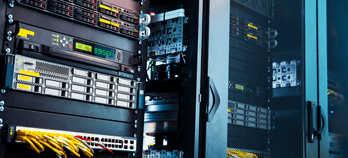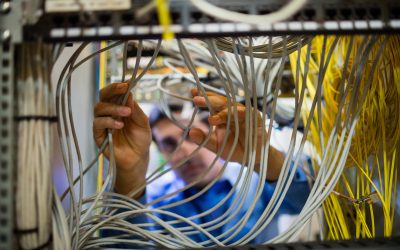Some tips for helping cool your Datacenter racks and cabinets

Tags: airflow | crac | reliability | servers
In Datacenters, cool air may enter a cabinet through the front door or through the bottom of the cabinet. The thermal management system within the cabinet should prevent the mix of cool and hot air between the front and rear of the cabinet, and exhaust hot air from the rear of the cabinet. Additional cooling improvements are possible including fitting baffles to guide cool air to the front of the equipment, rear door fans that will pull hot air out of the cabinet, bottom-mount blowers to blow cool air up the front of the cabinet, seals to close the space between the bottom of the cabinet and the floor, and rack-mounted air conditioners and liquid cooling.
Blanking panels can prevent internal hot air from recycling back. Here are several other best practices to consider.
Implement the TIA-942 hot aisle/cold aisle cabinet arrangement, which channels the cold and hot air.
Place multiple CRAC units throughout the data center, instead of a few large units. If a unit fails the others can maintain the room temperature, whereas if you use a few large units the data center may have to shut down until it’s repaired.
Use management software to control units. In many data centers the CRAC units battle each other as they try to maintain their individual settings so install humidistats on building columns and use these as inputs to the building management system to run the CRAC units.
Calibrate temperature and humidity sensors to make sure they are operating correctly.
Use management software to analyze and optimize computer workloads. Some workloads can be delayed to non-peak times, which balances the power and cooling load in the data center.
Utilize servers that can go into ‘sleep’ mode when not being utilized or use equipment with variable speed cooling fans that adjust fan speed to the heat load.
Utilize access flooring (aka “raised floor”) as the supply plenum for cold air so in design, the height of the floor (minimum of 450mm (18”)) should be sized to maintain clear air paths after cabling and piping is installed.

Written by James Donovan
You might also enjoy
FO Connector Contamination – A Constant Threat
Fiber optic communication most commonly works in duplex or multifiber transmission by transmitting light to a receiver in one direction on a fiber and receiving transmitted light back to a second receiver on the second fiber. Most engineers can understand that and...
Why Inspect and Clean Fiber Optic Connectors?
Inspecting and cleaning of fiber optic connectors during installation and when making any patching, is essential. Any contamination on a patch cord connector will be transferred through the coupler to the connector it is mated to. Even when testing fibers with a test...
Cleaning MPOs
MPO connectors should always be inspected with a scope before they are used, be that on a patch cord or a bulkhead. If they need to be cleaned, one-click cleaners are keyed to ensure the tip only fits one way onto the connectors and is able to clean both male and...


